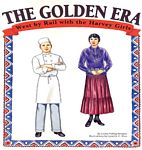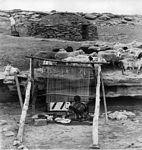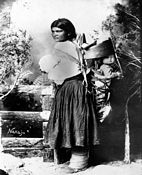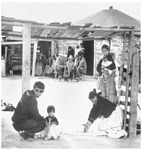Southwest & Santa Fe Style
It’s been called by many names, “Southwest Style”, “Pueblo Style”, “Santa Fe Style”, but no matter what term has been applied, everyone knows that particular Southwest style when they see it. And you see it in apparel, jewelry & accessories, art, music, dance—that enchanting and colorful blend of Spanish colonial and southwest native American Indian flavors and flair—Americana au Sonoran and Pueblo. From tasteful accents to complete “over-the-top” fashion puttogethers, Santa Fe style evokes a relaxed approach to lifestyle and concepts of beauty. The Navajo put it best: “Walk in beauty”.
This particular style began to permeate American cultural ideas during the Victorian Age and into the early to mid-20th Century when the Fred Harvey company started its travel and tour services to the Southwest and West. Later, the style was recaptured in Ralph Lauren's "Santa Fe Collection," 1981, taking the fashion global.
Fred Harvey’s famous “Harvey Girls” (young waitresses and hostesses at his train-stop establishments across the Southwest) adopted the Pueblo look, and the fashion made its way slowly back East. Dressed in adapted native-American Indian/Mexican-inspired broomstick skirts and velvet blouses adorned with concho belts and long liquid-silver necklaces, or silver and turquoise necklaces, the Harvey Girls were casually elegant and VERY appealing. Indian bracelets, silver hair combs and soft boots completed the vision.
Fred Harvey is largely credited with bringing Southwest culture, art and style to the rest of the United States.
He was an English immigrant who opened his first restaurant along the Santa Fe Railroad line in 1876 in Topeka, Kansas. From there the company grew into the first chain of restaurants and of railroad hotels.
Building his company’s reputation on the notion of civilizing rail travel to the West by selling good food served by respectable young, white, single women called “Harvey girls”, the entrepreneur combined hot meals, Harvey girls, and Indian images in his advertising, and presented the West as an exotic but accessible tourist paradise.
By the time of his death in 1901, his empire consisted of twenty-six restaurants, sixteen hotels, and twenty dining cars.
The Harvey Company went into the Indian art business at the suggestion of Harvey’s daughter, Minnie Harvey Huckel, who was an avid Indian art collector. In 1902 she suggested that a display of Indian art and handiworks be included in Harvey Company’s new Albuquerque hotel, the Alvarado.
Her husband, J. F. Huckel, a New York publisher was now a Fred Harvey vice president. He began to commute from Harvey headquarters in Kansas City to Albuquerque, where he created the Fred Harvey Indian Department. The collaboration with Harvey employee Herman Schweizer, a German immigrant, ensured the success of this venture.
Schweizer came to the American Southwest in the 1880s, and worked at jobbing silver and turquoise to Navajo silversmiths. While working at the Harvey restaurant in Coolidge, New Mexico, Schweizer had begun buying and selling Navajo arts and crafts—making it a a successful sideline. Minnie Huckel’s noticed, and from then on Schweizer spent the rest of his life managing the Fred Harvey Indian Department. He had an eye and a taste for the Indian art business and soon the Harvey Indian collection was a premiere showcase for the works.
This success was furthered by the architect Mary Colter, who helped design the Indian Building at the Alvarado. Colter subsequently went to work full time for the company and became a driving force in developing a regional architectural style, one that was inspired by local, native design. She developed spaces for “staged authenticity” that became fundamental to southwestern tourism. These customized and staged spaces were designed for commercial transactions which also seemed to offer a behind-the-scenes view of Indian homelife.
While some Indian men learned to participate in industrial age work, the Santa Fe’s tourist business affected the image of Indians as naturally artistic preindustrial craftspeople. Disembarking at Albuquerque, train travelers passed through the Harvey Indian Building on the way to the Alvarado lobby. The very first thing they saw were weavers, potters, silversmiths, and basket makers, all seemingly working as they always had been. This was pure deception, but a fantastically designed capitalist one; and Fred Harvey sales increased appreciably as a result of this encounter.
Many Indian artists worked at some point for the Fred Harvey Company. The San Ildefonso Pueblo potter Maria Martinez and her husband Julian worked as Harvey demonstrators early in their careers, before developing the black pottery style that brought so much fame. This style was not a historic style, but a newly derivative style, as much of the work of the time was.
The Hopi-Tewa potter Nampeyo also worked for the Harvey Company on a few occasions, demonstrating her Sikyatki revival style. Nampeyo had already begun to make a name for herself, which the Harvey Company cashed in on when they hired her.
During the spring of 1903, President Theodore Roosevelt included a two-hour stop in Albuquerque while on a speaking tour through the western territories. The Commercial Club of Albuquerque had chosen a Navajo woman, called Elle of Ganado, to weave a gift for the president—a textile rendition of his honorary Commercial Club membership card. Club members provided the design, which Elle wove quickly in hand-spun red, white, and blue yarn.
During his tour of Albuquerque, Roosevelt visited the Commercial Club, where he received Elle’s blanket, and he stopped by the Alvarado Hotel’s Indian Building, where he met the weaver herself. The newspaper reported that upon meeting the weaver, the “president gave her a hearty shake and told her how much he appreciated her work. The little speech was interpreted and pleased the Indian woman beyond expression.”
Elle, in contrast to other budding southwest artists, was not well-known until her work for the Harvey Company made her one of the only other Indian artists with name recognition in the early twentieth century.
Her apparent willingness to stay away from home for long periods of time and to be photographed over and over again made her one of the Harvey Company’s favorite employees, and local celebrities in Albuequerque.
Encouraged by their success in Albuquerque, the Harvey Company began employing demonstrators for other sites as well. Elle and other artists traveled around the country representing the company at expositions in San Francisco, Chicago, and elsewhere. They also worked in other Harvey houses, most notably at the Grand Canyon, where living exhibits of Indian “homelife” were built into the tourist “spaces”.
En And so, native American Indian, southwest or Navajo “Pueblo” style was the combination of Spanish colonial, Mexican, native American, German artisanship, British-American entrepreneurial spirit, showmanship, and promotion—without which we may never have been able to enjoy and appreciate this wonderful and truly American expression of style and culture




